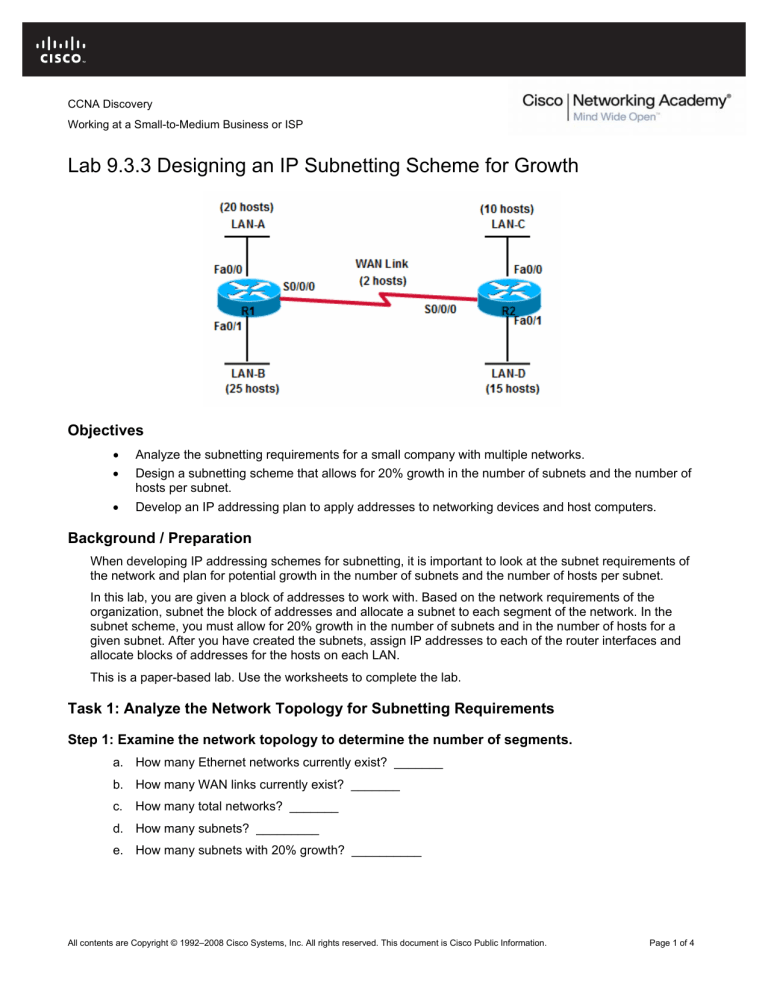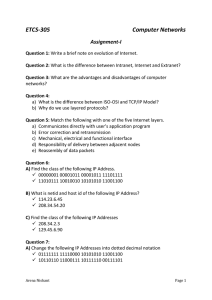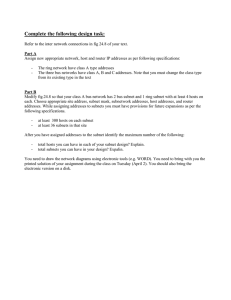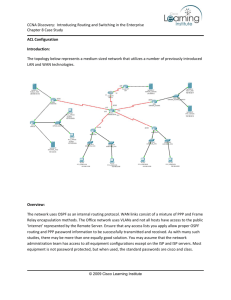
CCNA Discovery Working at a Small-to-Medium Business or ISP Lab 9.3.3 Designing an IP Subnetting Scheme for Growth Objectives • Analyze the subnetting requirements for a small company with multiple networks. • Design a subnetting scheme that allows for 20% growth in the number of subnets and the number of hosts per subnet. • Develop an IP addressing plan to apply addresses to networking devices and host computers. Background / Preparation When developing IP addressing schemes for subnetting, it is important to look at the subnet requirements of the network and plan for potential growth in the number of subnets and the number of hosts per subnet. In this lab, you are given a block of addresses to work with. Based on the network requirements of the organization, subnet the block of addresses and allocate a subnet to each segment of the network. In the subnet scheme, you must allow for 20% growth in the number of subnets and in the number of hosts for a given subnet. After you have created the subnets, assign IP addresses to each of the router interfaces and allocate blocks of addresses for the hosts on each LAN. This is a paper-based lab. Use the worksheets to complete the lab. Task 1: Analyze the Network Topology for Subnetting Requirements Step 1: Examine the network topology to determine the number of segments. a. How many Ethernet networks currently exist? _______ b. How many WAN links currently exist? _______ c. How many total networks? _______ d. How many subnets? _________ e. How many subnets with 20% growth? __________ All contents are Copyright © 1992–2008 Cisco Systems, Inc. All rights reserved. This document is Cisco Public Information. Page 1 of 4 CCNA Discovery Working at a Small-to-Medium Business or ISP Step 2: Document the current number of hosts on each network segment. a. Enter the network segment names in the table. Enter the number of hosts on each subnet, and then calculate the number of hosts the subnet must support if the number grows by 20%. Segment name Current number of hosts Number of hosts after 20% growth b. Which subnet must support the largest number of hosts? _____________ Task 2: Develop the Subnet Scheme Step 1: Determine the number of subnets and hosts. The customer has been assigned IP address block 172.20.99.0 /24 by their ISP. This provides 8 bits for hosts. a. How many total addresses do they have to work with before subnetting? ___________________ b. What is the decimal subnet mask for a /24 mask? ______________________ c. What is the minimum number of subnets required for the network design to allow for 20% growth? _________ d. How many bits must be borrowed from the host portion of the IP address to allow for that number of subnets, and how many total subnets can be created? __________ e. How many hosts (including the 20% growth) must the largest subnet support? __________ f. To support that many hosts, the number of host bits required is ______________ g. Does this subnet scheme allow for the number of subnets and hosts per subnet needed? ________ Step 2: Calculate the custom subnet mask. a. The address block assigned by the ISP is a /24 or 255.255.255.0. What is the custom subnet mask? _____._____._____._____, or /______ b. To which devices and interfaces is this mask assigned? __________________ Step 3: Identify the subnet and host IP addresses. a. Now that the subnet mask is identified, the network addressing scheme can be created. The addressing scheme includes the subnet numbers, the subnet broadcast address, and the range of IP addresses assignable to hosts. b. Complete the table showing all possible subnets for the 172.20.99.0 network. In the last column, enter the name of the network segment to which you are assigning the subnet. All contents are Copyright © 1992–2008 Cisco Systems, Inc. All rights reserved. This document is Cisco Public Information. Page 2 of 4 CCNA Discovery Working at a Small-to-Medium Business or ISP Subnet Subnet Address Broadcast Address Host IP Address Range Network Segment 0 1 2 3 4 5 6 7 Task 3: Document network device and host interfaces. Step 1: Document the network device interface IP addresses. Fill in the following table with the IP addresses and subnet masks for the router interfaces. Network Device Interface Addresses Network Device Segment Interface R1 LAN-A Fast Ethernet 0/0 R2 LAN-B Fast Ethernet 0/1 WAN Serial 0/0/0 LAN-C Fast Ethernet 0/0 LAN-D Fast Ethernet 0/1 WAN Serial 0/0/0 IP Address Subnet Mask Step 2: Document the host IP addresses. Fill in the following table with the IP addresses and subnet masks for the first host on each LAN. Assign the next available address to the first host computer on the LAN. Host Computer Interface Addresses Network Device Segment Interface IP Address Host 1 LAN-A NIC Host 1 LAN-B NIC Host 1 LAN-C NIC Host 1 LAN-D NIC Subnet Mask Default Gateway Task 4: Reflection a. With the initial block of addresses assigned by the ISP, and the requirements for future growth, is there any other subnetting scheme that could have worked? __________ b. If the maximum number of hosts per network segment was only 14, could you have used another scheme? ____ Why? _________________________________________________________ _______________________________________________________________________________ All contents are Copyright © 1992–2008 Cisco Systems, Inc. All rights reserved. This document is Cisco Public Information. Page 3 of 4 CCNA Discovery Working at a Small-to-Medium Business or ISP c. Although it works for the scenario in item b above, would it be a good idea to use 4 bits for subnets and 4 bits for hosts? _____ Why? ________________________________________________________ __________________________________________________________________________________ __________________________________________________________________________________ All contents are Copyright © 1992–2008 Cisco Systems, Inc. All rights reserved. This document is Cisco Public Information. Page 4 of 4



